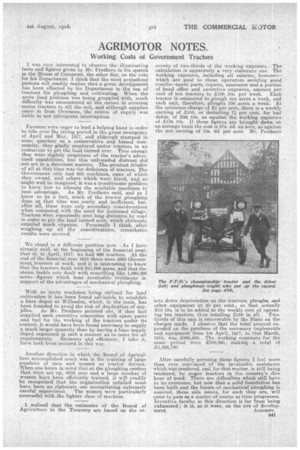AGRIMOTOR NOTES.
Page 17

If you've noticed an error in this article please click here to report it so we can fix it.
Working Costs of Government Tractors
I was very interested to observe the illuminating facts and figures given by Mr. Prothero in his speech in the House of Commons, the other day, on the vote for his Department. I think that the most prejudiced persons will readily realize that a great development has been effected by his Department in the use of tractors for ploughing and cultivating. When the acute food problem was being grappled with, much difficulty was encountered at the outset in securing motor tractors to till the soil, and although supplies came in from Overseas, the source of supply was liable to not infrequent interruption.
Farmers were eager to lend a helping hand in order to tide over the trying period in the great emergency of April and May, 1917, ana although stamped in some quarters as a conservative and biased community,they gladly employed motor tractors in an endeavour to get the. land turned over. True enough they were slightly suspicious of the tractor's advertised capabilities, but this unfounded distrust did not act in a deterrent manner. The greatest trouble of all at that time was the deficiency of tractors. The Government only had 660 machines, some of which they owned, and others which were hired, and as. might well be imagined, it was a troublesome problemk to know, how to allocate the available machines to best advantage. As Mr. Prothero said, and as know to be a fact, nitich of the tractor ploughing done at that time was costly and inefficient, but, after all, these were only secondary considerations when compared with the need for increased tillage. Tractors were repeatedly sent long distances by road in order to gbt the land turned over, which obviously entailed much expense. Personally I think, after weighing up all the -considerations, remarkable results were secured.
We stand in a different position now. --As I have already said, at the 'beginning of the financial year, that is, in April, 1917, we had 660 tractors. At the end of the financial year 1918 there were 3003 Government tractors at work, and it is interesting to know that the tractors dealt with 611,000 acres, and that the steam tackle sets dealt with something like 1,000,000 acres—figures which bear invaluable testimony in support of the advantages of mechanical ploughing.
With so many machined being utilized for land 'cultivation -it has been found advisable to establish a base depot at Willesden, which, in the main, has been founded to avoid the risk of duplication of sup plies. As Mr. Prothero pointed out, if they had supplied each executive committee with spare parts and fuel for the working of the tractors under its control; it would have, been found necessary to supply a much larger quantity than by having a base supply depot organized in such a manner as to cater for all requirements. Economy and efficiency, I take it, have both been secured in this way.
Another direction in which the Board of Agriculture accomplished much was 'in the training of large numbers of men and women as. tractor drivers. When one bears in mind that at the ploughing centres that were set up, 6000 men and a large number of women have been efficiently trained, it will readilybe recognized that the organization entailed must have been an elaborate one necessitating extremely careful supervision. The women were particularly successful with the lighter class of machine.
1 noticed that the estimates of the Board of Agriculture to the Treasury are based on the re covery of two-thirds of the working expenses. The calculation is apparently a very elaborate one. The working expenses, including all salaries, bonuses-which are paid to those operators securing good results—spare parts, repairs, insurance and a portion of head office and executive expenses, amount per unit of ten tractors to 2136 10s. per week. Each tractor is estimated to _plough ten acres a 'week, and each unit, therefore, ploughs 100 acres a week. At the minimum charge of 21 per acre, there is a weekly earning of 2100, or deducting 71per cent, for bad debts, of £92 108. as against the working expenses of£136 10s. If these figures are brought down on an acreage basis the cost is 27s. 4d. an acre, as against the net earning of 18s. 6d. per acre. Mr. Prothero
sets down depreciation on the tractors, ploughs, and other equipment at 20 per cent., so that actually 213 10n is to be added to the weekly cost of operat
ing ten tractors, thus totalling 2150 in all. Twothirds of this sum is recoverable by the State on the charges made. I observe that the total amount expended on the purchase of the necessary implements and equipment from 1st April, 1917, to 31st March, . 1918, was 2895,685. The working expenses for the same period were 2700,095, making a total of 21,595,780.
After carefully perusing these figures I feel more than ever convinced of the invaluable assistance which was rendered, and, for that matter, is still.being rendered, by inekor tractors in the country's dire hour of need. There are difficulties which still haveto be overcome, but now that a solid foundation has been 'built and the future of mechanical ploughing is assured, these side issues, for such they are, will come to pass as a matter of course as time progresses. Inventive faculty in this direction is far from being exhausted ; it is, -as it were, on the eve of develop
ment. A GRIIIOT.






















